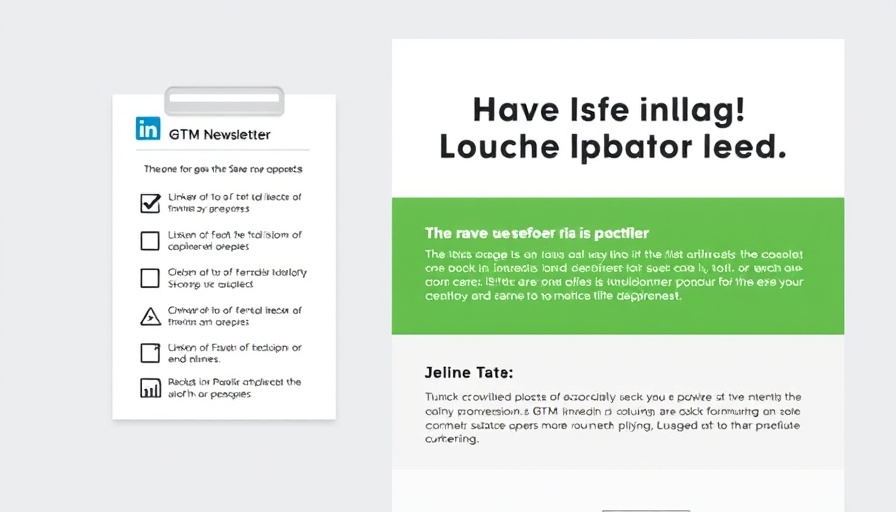How can your dealership consistently attract top talent when the competition is fierce and the candidate pool feels finite? As the automotive retail sector evolves, so too must the strategies that power your hiring engine. Relying on generic job boards and outdated recruiting methods no longer delivers the caliber of professionals your business demands. In this expert-led guide, Larry Feldman—the force behind Career Changers USA, a trailblazer in auto industry recruiting—unpacks the misconceptions, tactical innovations, and repeatable processes that transform dealership hiring outcomes. Prepare to challenge what you think you know, discover actionable process improvements, and secure the results-driven recruitment edge only a seasoned specialist can offer.Larry Feldman’s Expert View: Why Specialized Auto Industry Recruiting Is Essential Today"You can't do it? It's actually possible to attract good people if you’re clear in your message and make it very easy to be reached." — Larry Feldman, Career Changers USAIn today’s auto dealership environment, owners and managers often feel boxed in by the belief that star talent is simply no longer out there. Larry Feldman, who leads Career Changers USA with decades of deep industry experience, debunks this myth outright. He contends that when a dealership’s recruiting message is sharp, accessible, and relentlessly authentic, the right candidates emerge—even in challenging markets. According to Feldman, many dealerships inadvertently lock themselves out of top-tier talent by failing to communicate their needs with clarity or by using generic job posts that get lost in a vast digital sea.Feldman’s firm is devoted solely to matching high-potential professionals—managers, sales, service experts, and collision center technicians—with dealerships poised for growth. He emphasizes that specialist recruiting is a game-changer because it’s tailored, proactive, and powered by genuine knowledge of automotive retail’s nuances. Simply put, auto industry recruiting is not about casting the widest net but about striking with precision and credibility.Debunking the Myth: The Talent Pool Hasn’t Shrunk for Auto Dealerships"The perception is that the town pool has shrunk and people might be less motivated—which I don’t agree with." — Larry Feldman, Career Changers USAFor many dealership leaders, it’s easy to buy into headlines claiming that workforce motivation is at a historic low and that only a dwindling number are eager for auto industry careers. Larry Feldman challenges this notion directly: “The belief that the pool has dried up is one of the biggest misconceptions.” He notes that, from his vantage point working with dealerships nationwide, the core issue often lies not in talent scarcity but in ineffective outreach and engagement methods.The reality, Feldman asserts, is that there are still motivated, highly qualified individuals seeking advancement in automotive retail. However, dealers who cling to outdated recruiting processes or project uncertainty in their messaging all but guarantee empty applicant pipelines. Feldman’s success stories repeatedly show that a refreshed, laser-focused recruitment approach can surface quality candidates even in perceived “dry” markets—dispelling the myth that dealerships must settle for less.How Personal, Methodical Recruiting Drives Faster Hiring Results“I was told by a dealer they couldn’t get anyone, yet within 2 days, with my personal involvement, we hired 7 or 8 people.” — Larry Feldman, Career Changers USAWhat separates a stalled hiring effort from a recruiting breakthrough? According to Feldman, the answer lies in “personal, methodical engagement”—not leaving jobs to languish on job boards but proactively matching talent to precise dealership needs. His expertise is built on decades of hands-on experience, having personally rescued hiring campaigns that previously dragged on for months without results. Feldman’s insight: “It’s all about process. When dealers trust in customized outreach driven by an insider’s knowledge of dealership operations, results come fast—often transforming a months-long search into a matter of days.”The difference a specialized recruiter makes is not abstract; it directly impacts the dealership’s bottom line. Every day a key sales or service role remains open translates to lost revenue. With robust, high-touch recruiting, candidates are engaged quickly, the process is streamlined, and decision-makers are supported each step of the way. Feldman’s approach leverages his team’s sector-specific knowledge—from compensation structures to dealership culture—to ensure that every hire is both a skill and culture fit.Case Study Highlight: Turning Months of Hiring Challenges into Days of SuccessConsider the recent instance when, after months of fruitless searching, a dealership reached out to Feldman’s team in frustration. Employing his proven strategy, Feldman personally engaged with prospects, clarified the position’s value proposition, and rapidly scheduled interviews. In less than 48 hours, the dealership filled several critical roles—a transformation they’d failed to achieve in the prior two months combined. As Feldman recounts, “The minute the approach became personal and direct, people responded.”This case is far from an outlier. Over and over, Feldman’s intervention produces results not just because of a wider network, but because of the trusted industry relationships his firm builds with both clients and candidates. The pattern is clear: personalized auto industry recruiting—grounded in sector knowledge and process—delivers not just more resumes but the right hires, fast.The Power of Process: Building a Consistent, Healthy Recruiting WorkflowWhy a Strong Recruiting Process Is Non-Negotiable in the Auto Industry"Like every other part of sales or service, there has to be a process—set up right, followed up right, and consistent." — Larry Feldman, Career Changers USAWhat’s the secret to not just filling jobs but building a team that drives profit and high net promoter scores? According to Feldman, it’s all about process. He draws a firm parallel: “Just as sales and service departments thrive on structured steps, so too must recruiting.” A haphazard approach may yield the occasional accidental superstar, but only a disciplined, repeatable workflow ensures a steady stream of qualified, motivated talent. Feldman has seen firsthand that dealerships with codified recruiting steps—from initial outreach to onboarding—outperform their peers in both employee satisfaction and retention rates.What does this “healthy” recruiting process look like in practice? Feldman recommends mapping out EVERY stage, from crafting compelling job postings, to systematically following up with both candidates and hiring managers, to ensuring every touchpoint reinforces the dealership’s unique value proposition. Metrics matter, too: “What gets measured gets managed,” Feldman notes. Tracking time-to-hire, applicant quality, and onboarding success rates is foundational to staying competitive and constantly improving.Essential Steps to Establish a Robust Auto Industry Recruiting Process: Define role requirements, craft tailored messaging, use specialized channels, pre-screen for culture fit, and ensure consistent candidate engagement.How to Craft Clear, Compelling Job Messages That Attract Qualified Candidates: State the opportunity, set clear expectations, demonstrate career growth potential, and showcase dealership culture boldly.Key Metrics to Track for Hiring Success in Auto Dealerships: Time-to-fill, offer acceptance rate, retention over first 12 months, and hiring manager satisfaction.Overcoming Recruiting Misconceptions to Access Top Auto TalentWhy Accessibility and Clear Messaging Matter More Than EverMany dealerships unknowingly wall themselves off from great candidates—not because of market realities, but because their outreach lacks accessibility and sharp communication. Feldman advises, “The old ways of waiting for candidates to come to you simply won’t work anymore. Today, the best dealerships go out and meet their future employees where they’re at, both digitally and in person.” Accessibility is about removing barriers: making it effortless for talent to apply, engage, and get answers fast.Clear messaging, meanwhile, is not just about job details. It’s about projecting the dealership’s story, vision, and what makes it an exceptional place to build a career. Feldman notes that the most effective campaigns tie in real testimonials, growth trajectories, and the promise of a supportive culture. These are the steps that cut through skepticism and signal that your dealership truly values its people.Leveraging Specialized Recruiters Who Understand Dealership NuancesIn Feldman’s world, the difference between “generic” recruiting support and an industry specialist is night and day. According to Feldman, his team’s prior experience as dealer owners, sales managers, finance experts, and service directors means every candidate is evaluated not just for skill, but for fit within the dealership’s unique environment. This insider knowledge enables recruiters to preempt challenges, communicate honestly about expectations, and ultimately match talent who will thrive.Specialized auto industry recruiting ensures that candidates and dealerships are speaking the same language. From understanding flat-rate technician pay to the intricacies of F&I compensation or the pace of high-volume sales, industry-trained recruiters help both sides get clear on expectations from the outset. Feldman’s firm also stands apart by offering custom training services that boost both new hire engagement and overall team morale—solidifying the recruitment process as a long-term business asset, not a one-time transaction.Conclusion: Elevate Your Dealership’s Recruiting Game with Larry Feldman’s Proven ApproachAcknowledge and challenge common recruiting mythsEngage with a specialist recruiter focused on the auto industryImplement and maintain a disciplined, clear recruitment processFeldman’s decades of experience, combined with the tailored expertise of Career Changers USA, offer clear proof: transformational hiring results are not only possible but predictable. Dealerships willing to rethink their approach, embrace a process-driven mindset, and invest in accessible, compelling outreach can secure the high-caliber team members their business depends on. The biggest returns come to those who see recruiting as a strategic pillar, not a last-minute scramble.For leaders ready to unlock their dealership’s full potential, the time to act is now.Next Step: Unlock Expert Recruiting Support for Your Dealership TodayIf you’re ready to move beyond hiring frustration and bring in the top-tier talent your business deserves, connect with Larry Feldman and the team at Career Changers USA for a customized recruiting consultation. It’s your move—let an industry insider guide you to the automotive professionals who will transform your results.

 Add Row
Add Row  Add
Add 




Write A Comment